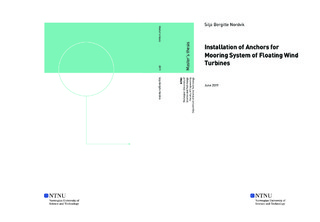| dc.contributor.advisor | Larsen, Kjell | |
| dc.contributor.author | Nordvik, Silja Bergitte | |
| dc.date.accessioned | 2019-10-17T14:08:47Z | |
| dc.date.available | 2019-10-17T14:08:47Z | |
| dc.date.issued | 2019 | |
| dc.identifier.uri | http://hdl.handle.net/11250/2622952 | |
| dc.description.abstract | Utvinning av havvind er dyrere enn vindkraft fra land, og dermed kan kostnadseffektiv og trygge marine operasjoner være avgjørende for å gjøre havvind konkurransedyktig. Hensikten med denne oppgaven er å se på den marine operasjonen å installere ankre som brukes til flytende vindturbiner ved å sammenligne et sugeanker og et droppanker. Relevant teori innen forankringssystemer, løfteoperasjoner, hydrodynamikk og operabilitet er presentert. Numeriske simuleringsmodeller av ankrene er laget i SIMA, og numeriske simuleringer og tidsdomeneanalyse er utført. Løfteoperasjonen er utført ved hjelp av et kranfartøy, og spenningen i løftelinen er først og fremst vurdert. Værdata er hentet fra Johan Castberg feltet i Barentshavet, og simuleringene er kjørt med uregulære bølger og varierende topperioder, signifikant bølgehøyde og retning.
Med tanke på den marine operasjonen, viser resultatene at droppankeret kan anbefales. Det skyldes at spenningen i løftewiren er lavere på grunn av mindre påvirkning fra hydrodynamiske krefter sammenlignet med sugeanker. Dette fører til et høyere designkriterium og operasjons grense. I tillegg er referansetiden kortere og dermed reduseres det nødvendige værvinduet.
For sugeanker er plaskesonen en kritisk fase siden tilleggsmassen er stor sammenlignet med den strukturelle massen på grunn av innesluttet vann. Slamming kreftene forekommer typisk for mindre topperioder og større akselerasjoner og gir mye dynamikk i løftewiren. En kombinert effekt av kranstipp bevegelsen og bølgekinematikk vil indusere den største vertikale hydrodynamiske kraften. Resultatene viser at lavere topperioder gir en høyere maksimal spenning i ledningen. Det er derfor viktig å vurdere slamming og Morisons krefter. I motsetning til droppankeret vil resonans i ledningen være en risiko. Når man vurderer tilgjengeligheten for installasjon, kan sesongvariasjoner være utfordrende for installasjon av sugeankeret og spesielt om man installerer flere ankre på rad for å unngå å vente på vær. | |
| dc.description.abstract | Recovering energy from offshore wind is more expensive than inshore and thereby can cost-effective and safe marine operations be crucial to make Floating Offshore Wind Turbines (FOWT) competitive. The purpose of this thesis is to look at the marine operation of installing anchors used for FOWT by comparing a suction anchor and a deep penetration anchor. Relevant theory within mooring systems, lifting operations, hydrodynamics and operability is presented. Numerical simulation models of the anchors are made in SIMA, and numerical simulations and time domain analysis is performed. The lifting operation is done by use of a crane vessel, and the tension in the lifting line is primarily assessed. Weather data is taken from the Johan Castberg Field located in the Barents Sea, and the simulations are run with irregular waves and varying peak periods, significant wave height and directions.
From a marine operation view, the results show that the deep penetration anchor is recommended. This is because the tension in the wire is lower due to less influence from hydrodynamic forces compared to the suction anchor. This leads to a higher design criterion and operational limit. In addition, the reference time is shorter and thereby the required weather window is reduced.
For the suction anchor, the splash zone is a critical phase as the added mass is large compared to the structural mass due to entrapped water. Slamming forces appear typically for smaller peak periods and larger accelerations and gives large dynamics in the wire. A combined effect of the crane tip motion and wave kinematics will induce the overall largest vertical hydrodynamic force. The results show that lower peak periods gives a higher maximum tension in the wire. It is, therefore, important to assess the slamming and Morison's forces. Opposed to the deep penetration anchor, resonance in the wire is a risk. When assessing the operability, it can be seasonal challenges for the installation of a suction anchor when comparing July with October, and especially when installing several anchors in a row to avoid waiting on weather. | |
| dc.language | eng | |
| dc.publisher | NTNU | |
| dc.title | Installation of Anchors for Mooring System of Floating Wind Turbines | |
| dc.type | Master thesis | |
